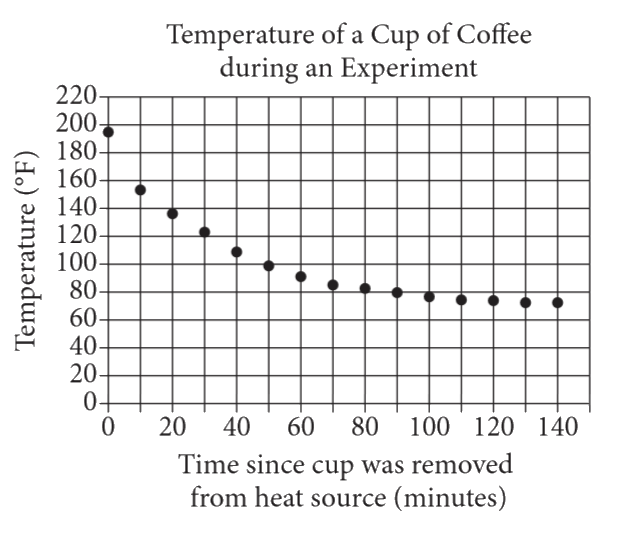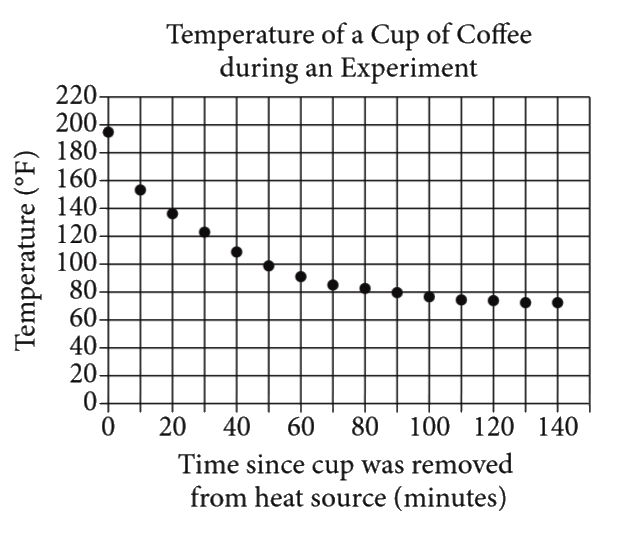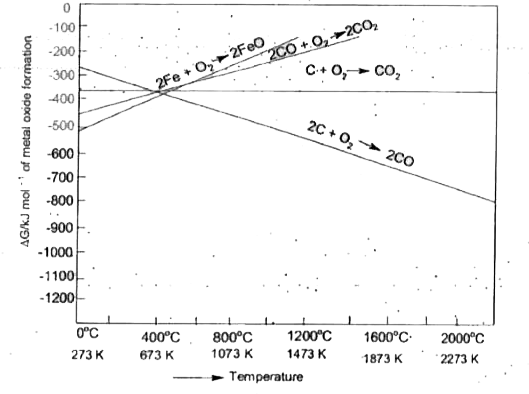In certain greenhouse for plants, the Fahrenheit temperature, F, is controlled so that it does not vary from 79∘ by more than 7∘. Which of the following best expresses the possible range in Fahrenheit temperature of the greenhouse?
|F−79|≤7
|F−79|>7
|F−7|≤79
|F−7|>79
The correct Answer is:A
To find the possible range of Fahrenheit temperature F in the greenhouse, we start by interpreting the information given in the problem.
1. Understanding the Variation: The temperature F is controlled so that it does not vary from 79∘ by more than 7∘. This means that the temperature can be as low as 79−7 and as high as 79+7.
2. Setting Up the Inequalities:
- The maximum temperature can be expressed as:
F≤79+7
- The minimum temperature can be expressed as:
F≥79−7
3. Calculating the Limits:
- Calculate the maximum temperature:
F≤79+7=86
- Calculate the minimum temperature:
F≥79−7=72
4. Combining the Inequalities:
- We can combine the inequalities to express the range of F:
72≤F≤86
5. Expressing in Absolute Value Terms:
- We can also express this range using absolute value notation. The statement F is within 7 degrees of 79 can be written as:
|F−79|≤7
Thus, the possible range in Fahrenheit temperature of the greenhouse is:
|F−79|≤7
- The maximum temperature can be expressed as:
F≤79+7
- The minimum temperature can be expressed as:
F≥79−7
- Calculate the maximum temperature:
F≤79+7=86
- Calculate the minimum temperature:
F≥79−7=72
- We can combine the inequalities to express the range of F:
72≤F≤86
- We can also express this range using absolute value notation. The statement F is within 7 degrees of 79 can be written as:
|F−79|≤7
|F−79|≤7
Topper's Solved these Questions
Similar Questions
In an experiment, the temperature of the reactants was being carefully monitored. It was observed that the maximum and minimum temperature recorded were 64.7∘Fahrenheit and 72.05∘ Fahrenhit . Which of the following inequalities represents all possible temperature values, t, observed during the experiment ?
View Solution
In an experiment, a heated cup of coffee is removed from a heat source, and the cup of coffee is then left in a room that is kept at a constant temperature. The graph above shows the temperature, in degrees Fahrenheit (.∘F), of the coffee immediately after being removed from the heat source and at 10-minute intervals thereafter.
Of the following, which best approximates the temperature, in degrees Fahrenheit, of the coffee when it is first removed from the heat source?
View Solution
Knowledge Check
A certain medication must be stored at a temperature, t, that may range between a low at 45∘ Fahrenheit a high of 85∘ Fahreheit. Which inequality represents the allowable range of Fahrenheit temperature?
A|t−65|≤20B|t+20|≤65C|t+65|≤20D|t−20|≤85a=1,052+1.08t
The speed of a sound wave in air depends on the air temperature. The formula above shows the relationship between a, the speed of a sound wave, in feet per second, and t, the air temperature, in degrees Fahrenheit (.∘F).
Which of the following expresses the air temperature in terms of the speed of a sound wave?At=a−1,0521.08Bt=a+1,0521.08Ct=1,052−a1.08Dt=1.08a+1,052C=59(F−32)
The equation above shows how a temperature F, measured in degrees Fahrenheit, relates to a temperature C, measured in degrees Celsius. Based on the equation, which of the following must be true?
I. A temperature increase of 1 degree Fahrenheit is equivalent to a temperature increase of 59 degree Celsius.
II. A temperature increase of 1 degree Celsius is equivalent to a temperature increase of 1.8 degrees Fahrenheit.
III. A temperature increase of 59 degree Fahrenheit is equivalent to a temperature increase of 1 degree Celsius.AI onlyBII onlyCIII onlyDI and II only

In an experiment, a heated cup of coffee is removed from a heat source, and the cup of coffee is then left in a room that is kept at a constant temperature. The graph above shows the temperature, in degrees Fahrenheit (.∘F), of the coffee immediately after being removed from the heat source and at 10-minute intervals thereafter.
During which of the following 10-minute intervals does the temperature of the coffee decrease at the greatest average rate?
View SolutionMetals are extracted from their ores by a wide variety of techniques. The most common ores are oxides. Most metals are obtained by direct treatment of theirs ores with chemical agents, but the extraction of certain others require electrolysis. An example of the former type of process is the extraction of iron from its oxide, described by the following equation :
Fe2O3+3C→2Fe+3CO
The relative ease of extraction of a metal from its oxide can be estimated using the Ellingham diagram, as shown in the figure.
The diagram plots the free energies of formation of various oxides per mole of consumed oxygen as a function of absolute temperature.

Which of the following best explains why the free energy of formation of Fe2O3 becomes less negative as the temperature is increased.
View SolutionCO2 and H2O absorbs strongly in the infrared region and its
presence in the atmosphere decreases the loss of heat from the
earth by radiation . This global warming is called the greenhouse
effect (other gases , including the oxides of nitrogen
from car exhaust freons from aerosols and refrigerators and
methane from bacteria in the soil and in the rumen cows , also add
to the greenhouse effect ). The concentration of atmospheric CO2
has increased by 10% . The is resulting in the increase in the mean temperature of the earth by 2.5∘C, varying form 2∘C the equator
to 4∘C at the poles . This could have dramatic effects on the
climate.
Which of the following is growing at a faster rate than CO2 and
thus responsible for the greenhouse effect ?
View SolutionThe temperature, t, in degrees Fahrenheit, in a certain town on a certain spring day satisfies the inequality |t−24|≤30. Which of the followig temperatures , in degrees Fahrenheit, is NOT in this range?
View Solutiona=1,052+1.08t
The speed of a sound wave in air depends on the air temperature. The formula above shows the relationship between a, the speed of a sound wave, in feet per second, and t, the air temperature, in degrees Fahrenheit (.∘F).
At which of the following air temperatures will the speed of a sound wave be closest to 1,000 feet per second?
View Solution
